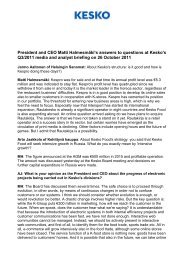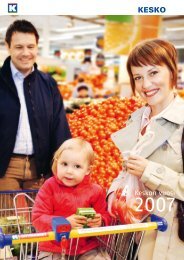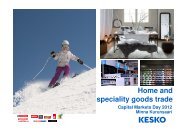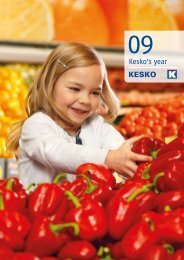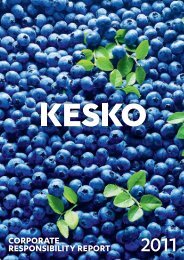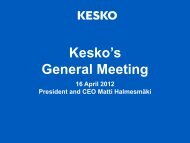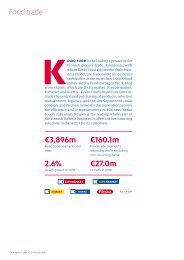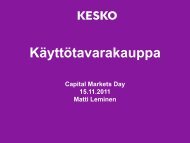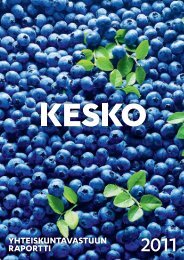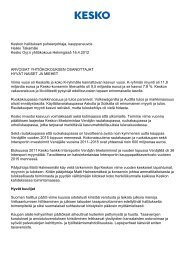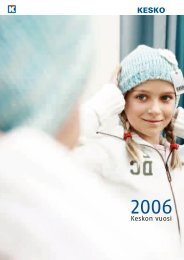Create successful ePaper yourself
Turn your PDF publications into a flip-book with our unique Google optimized e-Paper software.
154 <strong>Kesko's</strong> <strong>year</strong> <strong>2007</strong><br />
Glossary In this glossary we have compiled a list of some key terms used in the Annual Report.<br />
After-sales marketing refers in the car and<br />
machinery trade in particular to after-sales<br />
activities, such as maintenance, repairs, sales<br />
of spare parts, accessories and equipment.<br />
AMS is an abbreviation of AMS Sourcing BV.<br />
Kesko Food works in cooperation with the leading<br />
European food chains in AMS, and is a<br />
partner in the WorldWide Retail Exchange.<br />
The WWRE is a business-to-business web<br />
marketplace.<br />
Assortment is the number of product categories<br />
sold for different purposes (e.g. food, clothing,<br />
shoes, cosmetics, books and domestic<br />
appliances). The assortment can be wide, such<br />
as in department stores, or narrow, such as in<br />
speciality stores.<br />
Brand is a trademark, logo or branded product.<br />
It is an embodiment of all information relating<br />
to the company product or service. A brand is<br />
an image, created by the way of doing things,<br />
by quality and the willingness to reach the set<br />
destination.<br />
Certification of goods sold by stores is an<br />
audit carried out by an independent third to<br />
verify the compliance of operating systems<br />
with certain criteria (e.g. with an ISO<br />
standard).<br />
Chain agreement is a contract between the<br />
retailer and Kesko that enables the retailer join<br />
one of Kesko’s retail store chains. Under the<br />
terms of the chain agreement, the retailer and<br />
Kesko agree on their rights and responsibilities<br />
regarding chain operations.<br />
Chain concept is a comprehensive description<br />
of retail business operations and guidelines for<br />
their similar implementation in all stores of<br />
the chain.<br />
Chain Executive Committee is a body elected<br />
by retailers from their midst. It can make proposals<br />
and give opinions to the chain unit in<br />
matters concerning chain cooperation.<br />
Chain planning groups are groups that plan<br />
different areas of chain operations. They<br />
include chain retailers, their personnel and<br />
chain unit representatives.<br />
Chain selection in the K-Group is that part of a<br />
selection which is the same in all stores of the<br />
chain. The chain unit makes decisions concerning<br />
the selection.<br />
Chain unit is the Kesko unit responsible for<br />
store chain operations and chain concept development<br />
in the K-Group. It has decision-making<br />
power in matters concerning the chain.<br />
Corporate responsibility refers to voluntary<br />
responsibility towards key stakeholders. It is<br />
measurable, based on the company’s values<br />
and objectives, and is divided into economic,<br />
social and environmental responsibility.<br />
Customer value refers to the chain’s way of<br />
defining and communicating the benefits or<br />
values that it generates to the customer.<br />
Dealer, for instance in the car trade, is a company<br />
authorised by the importer to sell and<br />
service branded products. The dealer meets the<br />
quality standards set by the manufacturer and<br />
the importer.<br />
Department store is a retail store that sells a<br />
wide variety of goods. Its sales area is at least<br />
2,500 m 2 . In a department store, no product<br />
category accounts for over half of the total<br />
sales area.<br />
Discounter (discount store) is a store type that<br />
relies on low prices as competitive tools. Typical<br />
features of a discounter also include a varying<br />
selection of home and speciality goods,<br />
self-service, and warehouse-type displays.<br />
Distance sales refers to trading activities<br />
where customers do not visit store premises,<br />
but instead trade through the Internet, other<br />
electronic media or mail order.<br />
Fair trade is a form of international trade,<br />
illustrated by a formalised parrot logo. The<br />
logo indicates that business is carried out<br />
directly with small producers of the third world<br />
without intermediaries. Producers receive a<br />
guaranteed price for their products that is usually<br />
significantly higher that the world market<br />
price. They are also given guarantees of long<br />
contracts and opportunities for advance<br />
financing.<br />
Groceries refer to food and other everyday<br />
products that people are used to buying when<br />
they shop for food. Groceries include food,<br />
beverages, tobacco, home chemical products,<br />
household papers, magazines and cosmetics.<br />
Grocery store is, in most cases, a self-service<br />
food store that sells the full range of the above<br />
groceries. Food accounts for about 80% of grocery<br />
stores’ total sales.<br />
Home and speciality goods stores include<br />
clothing, shoe, sports, home technology, home<br />
goods, furniture and interior decoration stores.<br />
HoReCa is a category consisting of large customers<br />
in the food trade, including hotels, restaurants<br />
and other catering companies.<br />
Hypermarket is a retail store selling a wide<br />
variety of goods mainly on the self-service principle.<br />
Its sales area exceeds 2,500 m². In a<br />
hypermarket, food accounts for about half of<br />
the total area, but sales focus on groceries<br />
(food and other everyday items).<br />
Hypermarket centre is usually located on one<br />
level. The hypermarket accounts for over 50%<br />
of the total business premises.<br />
Intellectual capital refers to the resource that<br />
arises from the mutual interaction between the<br />
knowledge and competencies of the individuals<br />
operating in the organisation, the attitudes<br />
prevailing in the organisation and its environment,<br />
and the data management and communications<br />
systems. The company’s intellectual<br />
capital arises from information, data and<br />
competencies.<br />
K-Group consists of the K-retailers, the K-Retailers’<br />
Association and the Kesko Group.<br />
K-retailer is an independent chain entrepreneur<br />
who, through good service, competence<br />
and local expertise, provides additional<br />
strength for chain operations. The K-retailer<br />
entrepreneurs are responsible for their stores’<br />
customer satisfaction, personnel and profitable<br />
business operations.<br />
K-Retailers’ Association is a body that looks<br />
after the interests of the K-retailers. Its key<br />
function is to promote and strengthen the conditions<br />
for the entrepreneurial activities of<br />
K-retailers. All the K-retailers – about 1,285 –<br />
are members of the K-Retailers’ Association.




